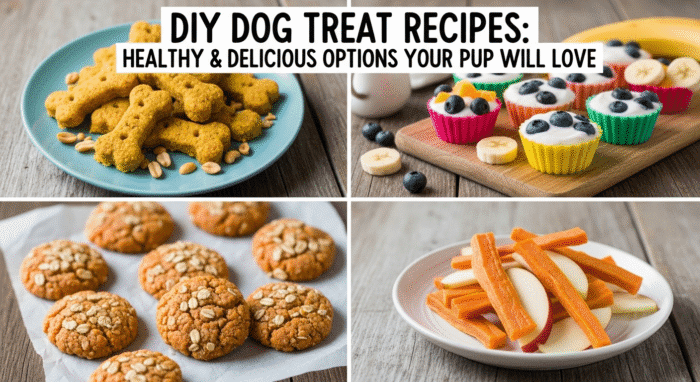Okay, let’s be real. How many times have you looked at that bag of dog treats and thought, “What is actually in this stuff?” I know I have. And the ingredients list? Forget about it. Half of them sound like they belong in a science lab, not my furry friend’s tummy. That’s why I started experimenting with homemade dog treats, and honestly? It’s been a game changer.
I’m not a chef, by any means. More like a moderately competent human in the kitchen. But even I can whip up some seriously delicious and healthy snacks for my pup. And the best part? You know exactly what’s going into them. No weird preservatives, no questionable fillers, just good, wholesome ingredients. Plus, it’s kinda fun!
But (yes, I’m starting a paragraph with ‘but’) there’s a bit of a learning curve. You can’t just throw a bunch of random ingredients together and hope for the best. Some things that are perfectly fine for humans are a big no-no for dogs. Chocolate, grapes, onions…the list goes on. So, before you start baking, let’s get clear on the basics. I mean, we don’t want to inadvertently poison our best pals, right?
Table of Contents
Understanding Dog-Safe Ingredients

So, what can dogs eat? That’s the million-dollar question. The answer is…more than you might think! We’re not talking about table scraps (though there are exceptions!). I’m talking about ingredients that provide genuine nutritional value. Think about this way: what would a healthy, balanced canine diet actually consist of in the wild? We are domesticated, yes, but our anatomy is very similar.
Think lean proteins like chicken, turkey, or beef. Healthy fats from fish oil or coconut oil. And a variety of fruits and vegetables – carrots, sweet potatoes, blueberries, apples (without the core and seeds, of course!). These are all fantastic bases for DIY dog treat recipes. Thinking sustainably extends to treat-making too!
Here’s something I’ve learned over the years: simplicity is key. You don’t need a million different ingredients to create a tasty and nutritious treat. In fact, the fewer ingredients, the better, in my opinion. It reduces the risk of allergies or sensitivities, and it makes the whole process a lot less stressful.
Easy & Delicious DIY Dog Treat Recipes
Alright, let’s get to the good stuff! Here are a few of my go-to recipes that my dog absolutely loves. And trust me, she’s a pretty discerning customer. Remember to adjust portion sizes based on your dog’s size, age, and activity level. We don’t want any pudgy pups!
- Peanut Butter & Banana Bites: This is about as simple as it gets. Mash one ripe banana with a tablespoon of natural peanut butter (make sure it doesn’t contain xylitol, which is toxic to dogs!). Roll the mixture into small balls and bake at 350°F (175°C) for about 15 minutes, or until lightly golden.
- Sweet Potato Chews: Slice a sweet potato into thin strips and bake at 250°F (120°C) for 3-4 hours, or until they’re chewy and dehydrated. These are great for dental health!
- Chicken & Rice Meatballs: Combine cooked chicken (shredded), cooked rice, and a little bit of broth. Roll into small meatballs and bake at 375°F (190°C) for about 20 minutes. My dog goes crazy for these! Think of the ways to expand here… carrots, kale, celery. So many options!
Honestly, I have no baking talent. That is to say that I’m not winning any baking awards. However, with these recipes I am pretty confident that you can do it even if you have zero experience.
These are just starting points, of course. Feel free to experiment with different ingredients and flavors to find what your dog loves best. Just always double-check to make sure everything is safe for canine consumption. There are tons of resources online (like the American Kennel Club) to help you figure out what’s safe and what’s not.
The Benefits of Homemade Treats (and Why You Should Bother)
You might be wondering, is all this effort even worth it? I mean, you can just buy a bag of treats at the store, right? And that’s true. But here’s the thing: when you make your own treats, you have complete control over the ingredients. No mystery additives, no hidden sugars, no questionable preservatives. And as the saying goes: you get what you pay for.
Plus, there’s something incredibly satisfying about knowing that you’re providing your dog with healthy, wholesome snacks that they genuinely enjoy. It’s a small act of love, really. And let’s be honest, our dogs deserve all the love we can give them. Did you know that treats can be more than just a tasty reward? I had read in one article that DIY dog enrichment can prevent boredom, and treats can be part of that.
Oh, and think about it this way: you can customize the treats to your dog’s specific needs. Does your dog have allergies? No problem, just avoid those ingredients. Is your dog overweight? You can create low-calorie treats. The possibilities are endless. Plus, you can use those amazing cookie cutters you bought and customize the treat in fun shapes.
Honestly, the frustrating thing about this topic is that I could probably write a whole book about it. There’s just so much to learn and explore when it comes to DIY dog treats. But for now, I hope this has given you a good starting point.
FAQ: Your Homemade Dog Treat Questions Answered
How do I know if my dog has a food allergy?
This can be tricky. Look for symptoms like excessive scratching, skin rashes, digestive issues (vomiting, diarrhea), or ear infections. The best way to determine a food allergy is through an elimination diet, working with your veterinarian. You’ll gradually reintroduce ingredients to see what triggers the reaction. It’s a slow process, but worth it to identify the culprit and keep your furry friend healthy.
What’s the best way to store homemade dog treats?
That depends on the type of treat! For softer, more perishable treats (like those peanut butter and banana bites), store them in an airtight container in the refrigerator for up to a week. For drier treats (like the sweet potato chews), you can store them in an airtight container at room temperature for a couple of weeks. You can also freeze treats for longer storage – just thaw them out before serving.
Can I use honey or maple syrup to sweeten my dog treats?
Yes, you can, but use them sparingly! Both honey and maple syrup are high in sugar, so they should be used as occasional treats, not as a regular part of your dog’s diet. Too much sugar can lead to weight gain and dental problems. Opt for natural sweetness from fruits like bananas or applesauce instead.
Are there any ingredients I should absolutely avoid when making DIY dog treat recipes?
Absolutely! There are several ingredients that are toxic to dogs, including chocolate, grapes, raisins, onions, garlic, macadamia nuts, avocados, and anything containing xylitol (a sugar substitute). Always double-check your ingredient list before you start baking to make sure everything is safe for your pup.
My dog is a picky eater. How can I get them to eat homemade treats?
Ah, the picky eater! Try starting with small amounts of highly palatable ingredients like cooked chicken or peanut butter. You can also try adding a little bit of broth or yogurt to the treats to make them more appealing. And don’t be afraid to experiment with different flavors and textures until you find something your dog loves.

